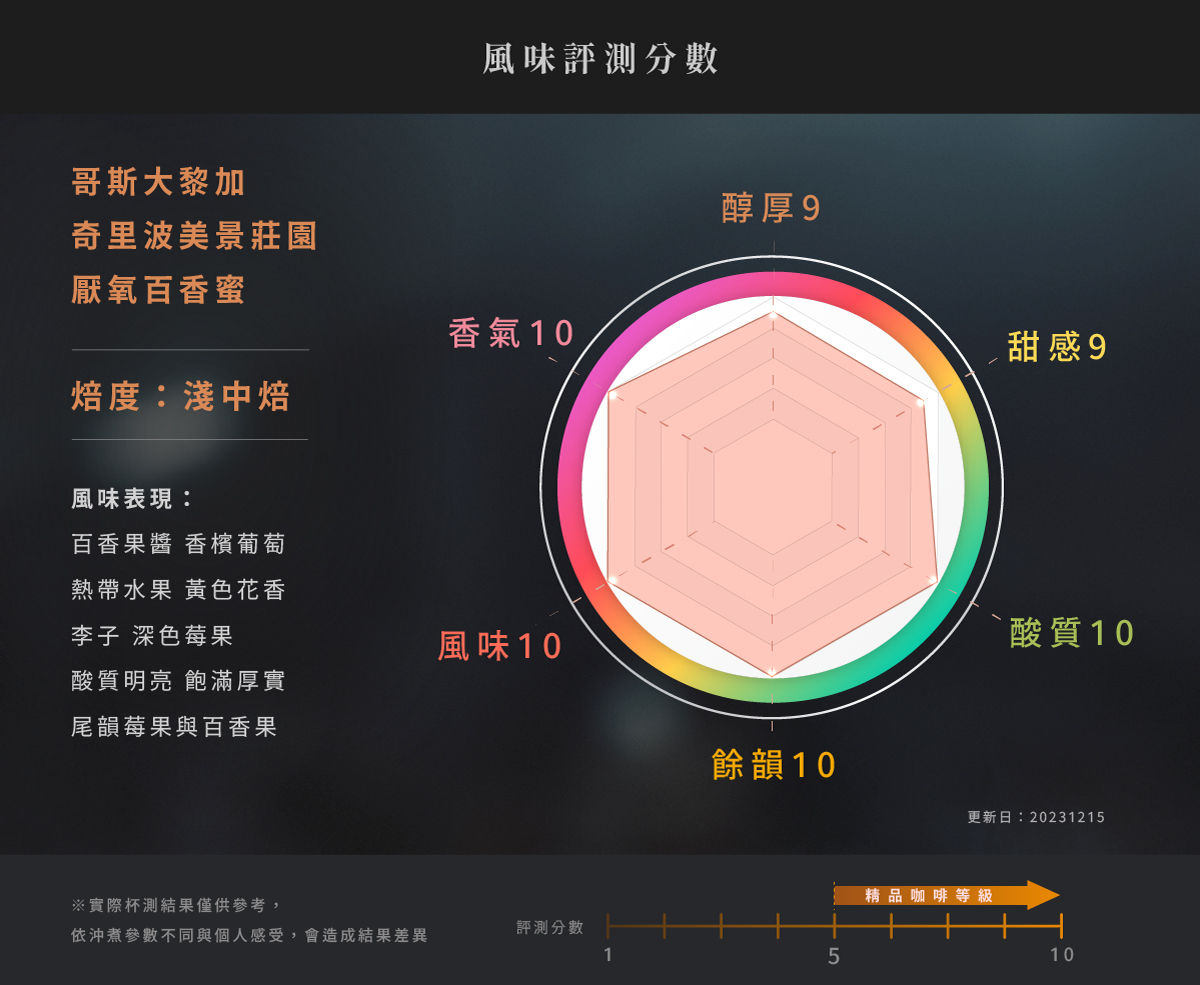

Costa Rica Brunca Rivense Finca Vista al Chirripo Anaerobic Passion Honey










Coffee Flavor
The flavors of coffee are derived from the breakdown of various nutrients in the green coffee beans during roasting. Heat causes these compounds to degrade into a variety of aromatic molecular structures, resulting in a wide spectrum of flavors. High-quality coffee beans naturally possess a rich aroma that evolves at different temperatures—high, medium, and low—offering a delightful and nuanced experience worth savoring.
Costa Rica Brunca Rivense Finca Vista al Chirripo Anaerobic Passion Honey
Passion fruit jam, Champagne grape, tropical fruits, yellow floral aroma, plum, dark berries, bright acidity, full-bodied and rich, with a berry and passion fruit finish.

奇里波美景莊園Finca Vista al Chirripó is located in the remote coffee-growing region of Branca, offering a stunning view of Costa Rica's highest mountain, Chirripó. Inspired by the breathtaking sunrises seen from the farm each morning, the Ureña Rojas family named it "Vista al Chirripó," meaning "Chirripó View Estate."
里瓦斯人處理廠Café Rivense del Chirripó, a family-run micro-mill, was founded in 2005 by Régulo Ureña and Isabel Rojas, who have been cultivating coffee for over 30 years. The anaerobic passion honey batch introduced this time comes from their highest-altitude coffee farm, reaching up to 1,805 meters. The land was prepared at the end of 2014, and seedlings were planted in early 2015. Different sections at elevations between 1,700 and 1,775 meters are dedicated to varieties such as Caturra, Catuai, and Villa Sarchi, while the highest area, around 1,800 meters, is reserved for Geisha.
The farm operates under a sustainable management system focused on reducing its environmental carbon footprint. Proper shading enhances soil organic matter while keeping the coffee trees fresh. Fertilization is based on annual soil analysis, herbicides are used only in areas with aggressive weed growth, and all water sources are protected. Additionally, fruit trees are planted throughout the farm to support local wildlife.
The farm began participating in the Costa Rica Cup of Excellence (COE) competition several years ago, achieving 33rd place in 2015. In 2016, it was visited for the first time by an SCAA Roasters Camp, connecting them with international specialty coffee buyers. Even Blue Bottle Coffee, a pioneer of the third-wave coffee movement, discovered the estate and has since increased its purchasing volume each year. The farm has also earned the Costa Rica National Winner award. In 2019, Café Rivense del Chirripó placed 5th in the COE!

The coffee tree, botanically classified under the Rubiaceae family and the Coffea subgenus, is an evergreen tree. Coffee beans are the seeds of the coffee fruit. There are three main varieties: Arabica, Robusta, and Liberica. These three varieties cannot crossbreed to produce different subspecies. The world’s specialty coffee comes from the Arabica variety, and within Arabica, there are various subspecies resulting from evolution, hybridization, and mutation. The world's specialty coffees are derived from Arabica, which itself has various subspecies and hybrids resulting from evolution, crossbreeding, and mutations.
Caturra
Caturra, the Arabica coffee variety, is a mutant of Bourbon and was first discovered in Brazil. The taste has a sour taste of lemon or citrus, and it has a fruity taste in terms of sweetness. Although the sweetness is not as good as Typica and Bourbon, the sweetness can be very good when properly roasted. The sweetness of Caturra is determined by the number and dosage of fertilizers applied by the grower, and the harvest period takes 2 years, and the cost of care is high, so the yield is still limited.

(Coffee Processes)
The term "processing methods" refers to the process of transforming ripe red coffee cherries into dried green beans. Each method has its advantages and disadvantages, influenced by the natural environment and the specific needs of the coffee-producing region. As a result, different regions adopt the processing method most suited to their conditions. This batch uses the following Passion Honey methods, described below:
Anaerobic Processing Method
In this method, coffee cherries are placed in a sealed container filled with carbon dioxide, creating an oxygen-free environment. The low-temperature conditions slow down the breakdown of mucilage sugars and cause the pH level to decrease at a slower rate, extending the fermentation time. This process enhances sweetness and achieves a more balanced flavor profile.
The slow and prolonged fermentation helps develop a smooth, rounded taste while preventing undesirable dryness or excessive acetic acid. The sealed environment also retains aromatic compounds, preventing them from evaporating. After the anaerobic process, the coffee is further processed using the passion honey method.
Passion Honey Process
At Café Rivense del Chirripó, where honey processing is already highly refined, the team has developed an advanced version of Black Honey processing—the Passion Honey Process.
Honey processing involves removing the coffee cherry’s skin and pulp while retaining the mucilage, which is then dried under sunlight. The term "honey" refers to the sticky, nectar-like consistency of the mucilage. The amount of mucilage retained significantly impacts the coffee’s flavor intensity and increases the complexity of fermentation.
Not satisfied with traditional honey processing, Café Rivense del Chirripó pioneered an even more advanced method: Passion Honey Process. This process retains 80% of the mucilage, with a key difference from Black Honey processing—it extends the drying time to over three weeks, sometimes up to a month. The goal is to intensify the sweetness and fruitiness within the beans.
This extended drying period requires precise control over humidity, temperature, and airflow. The beans are meticulously hand-turned daily on raised drying beds, with defective beans carefully removed. The entire process is conducted at lower temperatures to preserve delicate flavors.
As a result, Passion Honey coffee exhibits an intense tropical fruit profile, inspiring its name.
-------
Café Rivense del Chirripó Anaerobic Passion Honey Processing Method
From morning to midday, ripe coffee cherries are handpicked when they reach a deep red-purple color. In the afternoon, the freshly harvested cherries are transported to the processing area, where their skins are removed using a mechanical depulper—without the use of water. The depulped cherries are then placed in baskets and transferred to raised drying beds.
In this method, the depulped cherries undergo a pre-drying phase on raised beds for five days. This stage concentrates the sugars in the fruit, enhancing the coffee’s flavor profile. Next, the cherries are sealed in plastic bags and stored in a fully shaded warehouse for anaerobic fermentation. The fermentation period lasts between 10 to 12 days, during which the risk of over-fermentation and contamination is high. Therefore, the entire process is carefully managed at low temperatures to ensure quality control.
After fermentation is complete, the coffee undergoes mechanical drying for 48 hours at an average temperature of 35°C to 40°C until the moisture content reaches 10%.





JUSTIN INTERNATIONAL FOOD ENTERPRISE CO., LTD.
Tel: +886-3-358-6611
1st Floor, No. 30, Lane 120, Daxing Road, Taoyuan District, Taoyuan City
▶This product is covered by a NT$10 million product liability insurance.
▶Food Industry Registration Number: F-165601955-00000-0
▶ Our company’s cupper is certified as a CQI International Coffee Quality Appraiser.



Recommended Products

